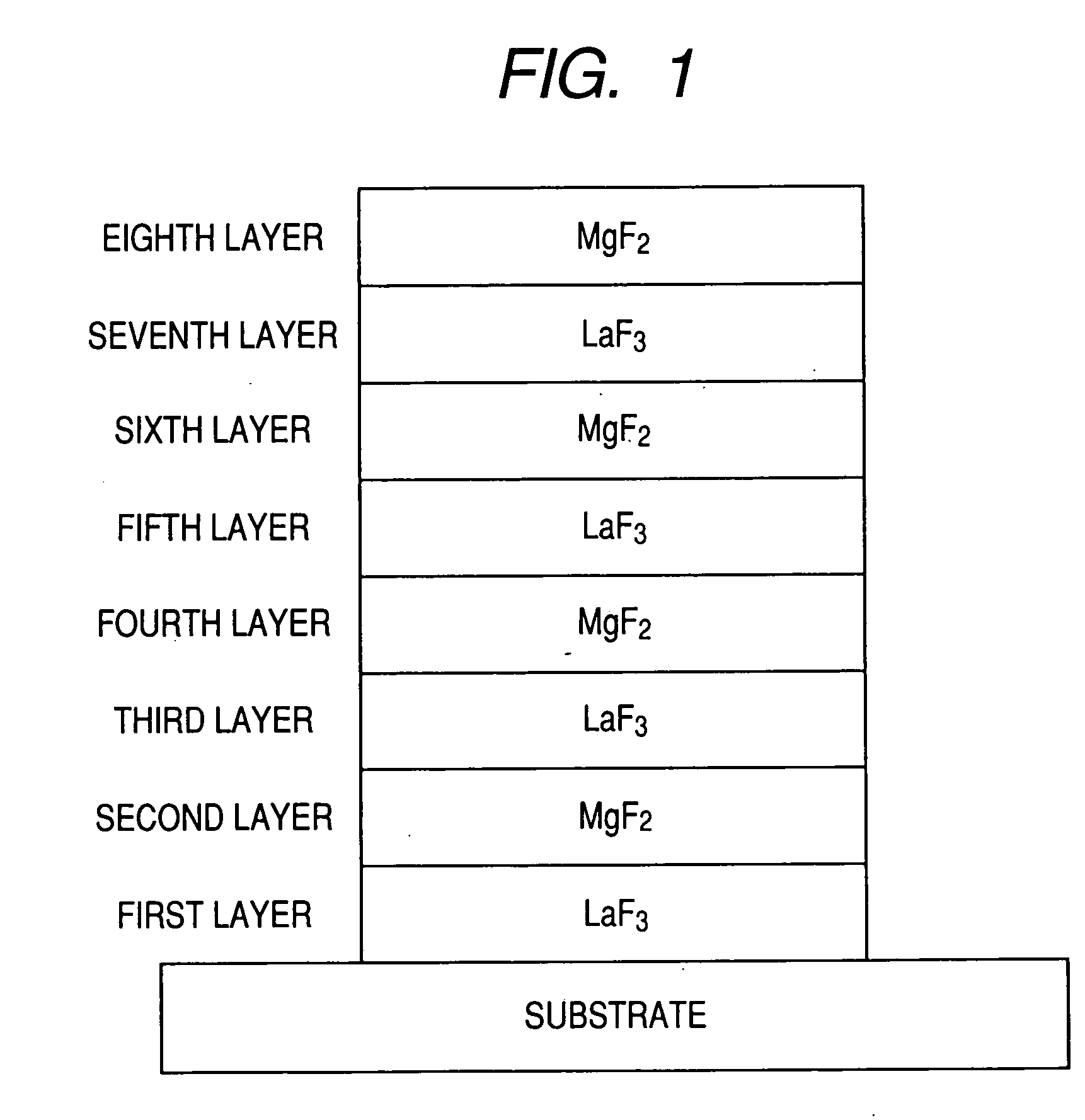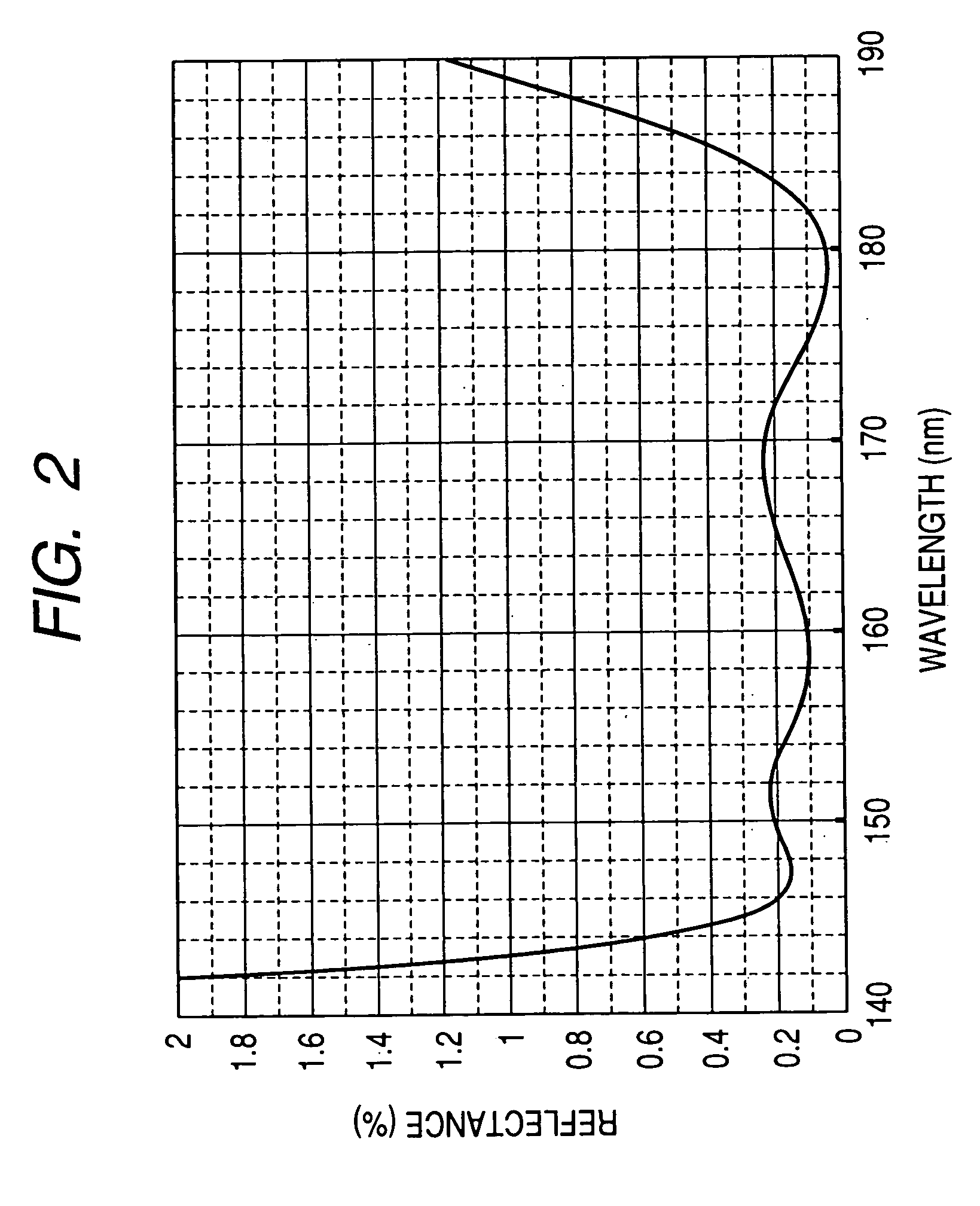Anti-reflective film and optical element having anti-reflective film
a technology of anti-reflective film and optical element, which is applied in the field of anti-reflective film, can solve the problems of not being able to make reflectance low for a light, having 6 layers of anti-reflective film, and having no effect on light reflection, etc., and achieves good characteristics, good characteristics, good effects
- Summary
- Abstract
- Description
- Claims
- Application Information
AI Technical Summary
Benefits of technology
Problems solved by technology
Method used
Image
Examples
example 1
[0029]FIG. 1 is a schematic view showing an anti-reflective film consisting of eight layers for F2 laser (157 nm) in accordance with Example 1 of the present invention. The anti-reflective film of the present example was prepared using an LaF3 film with a refractive index of 1.765 at a wavelength of 157 nm for a high refractive-index layer, and an MgF2 film with a refractive index of 1.466 at a wavelength of 157 nm for a low refractive-index layer. Table 1 shows the optical film thickness of each layer of the anti-reflective film for ultraviolet light with a designed central wavelength of λ0=157 nm. The refractive-index layers were sequentially formed by use of a vacuum evaporation method so as to have the thicknesses shown in Table 1, respectively. In the present example, calcium fluoride was used as a substrate.
TABLE 1Optical FilmMaterialThicknessMedium on lightairincidence sideEighth layerMgF20.2588λ0Seventh layerLaF30.2639λ0Sixth layerMgF20.2614λ0Fifth layerLaF30.1138λ0Fourth ...
example 2
[0035] An anti-reflective film in accordance with the present example has a six-layer structure having high refractive-index layers and low refractive-index layers alternately stacked. The anti-reflective film was prepared using an LaF3 film with a refractive index of 1.765 at a wavelength of 157 nm for a high refractive-index layer, and an MgF2 film with a refractive index of 1.466 at a wavelength of 157 nm for a low refractive-index layer. Table 2 shows the optical film thickness of each layer of the anti-reflective film for ultraviolet light with a designed central wavelength of λ0=157 nm. The refractive-index layers were sequentially formed by use of a vacuum evaporation method so as to have the thicknesses shown in Table 2, respectively. In the present example, calcium fluoride was used as a substrate.
TABLE 2OpticalFilmMaterialThicknessMedium on lightairincidence sideSixth layerMgF20.2534λ0Fifth layerLaF30.2645λ0Fourth layerMgF20.2667λ0Third layerLaF30.1207λ0Second layerMgF20...
example 3
[0038] An anti-reflective film in accordance with the present example has a six-layer structure having high refractive-index layers and low refractive-index layers alternately stacked. The anti-reflective film was prepared using an LaF3 film with a refractive index of 1.765 at a wavelength of 157 nm for a high refractive-index layer, and an MgF2 film with a refractive index of 1.466 at a wavelength of 157 nm for a low refractive-index layer. Table 3 shows the optical film thickness of each layer of the anti-reflective film for ultraviolet light with a designed central wavelength of λ0=157 nm. The refractive-index layers were sequentially formed by use of a vacuum evaporation method so as to have the thicknesses shown in Table 3, respectively. In the present example, calcium fluoride was used as a substrate.
TABLE 3OpticalFilmMaterialThicknessMedium onairlightincidencesideSixth layerMgF20.269λ0Fifth layerLaF30.274λ0Fourth layerMgF20.57λ0 Third layerLaF30.205λ0Second layerMgF20.079λ0...
PUM
| Property | Measurement | Unit |
|---|---|---|
| wavelength | aaaaa | aaaaa |
| wavelength | aaaaa | aaaaa |
| wavelength | aaaaa | aaaaa |
Abstract
Description
Claims
Application Information
 Login to View More
Login to View More - R&D
- Intellectual Property
- Life Sciences
- Materials
- Tech Scout
- Unparalleled Data Quality
- Higher Quality Content
- 60% Fewer Hallucinations
Browse by: Latest US Patents, China's latest patents, Technical Efficacy Thesaurus, Application Domain, Technology Topic, Popular Technical Reports.
© 2025 PatSnap. All rights reserved.Legal|Privacy policy|Modern Slavery Act Transparency Statement|Sitemap|About US| Contact US: help@patsnap.com



